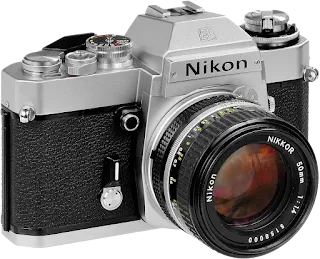[Nikon] Nikomat ELW / Nikon EL2 | Film Cameras | 1977
Nikomat ELW / Nikon EL2
The Nikomat ELW was introduced in early 1976 as a minor change model from the Nikomat EL (released in 1972). In April of the same year, the "Canon AE-1" was released alongside the "Power Winder A". This camera, marketed in Japan with the slogan "Continuous Shooting SLR", swept the camera market, selling over 9 million units.
The author of this article, who used to work in the design department at Nippon Kogaku, recalls feeling bitter when a sales representative from an electronic parts company asked, "Isn't Nippon Kogaku going to make a 'Continuous Shooting SLR'?" This was because the sales representative was unaware that Nippon Kogaku had been a pioneer in auto film advance and continuous shooting since the Nikon S2 and SP eras.
At this time, winders and motor drives were available as accessories for SLR cameras, and auto film-advance became a popular feature. Nippon Kogaku’s solution to the market demand at the time was the Nikomat ELW.
Original Plan The Nikomat ELW was a minor-change model, attaching the "Autowinder AW-1" to the Nikomat EL. The additional components included the film-advance coupling at the bottom of the camera, an electric contact point to trigger film-advance, and a shutter release button lock lever ("shutter button switch"). These features were carried over to the next Nikon EL2 (1977).
In fact, from the beginning of the project, there were plans to add an automatic film winding mechanism to the Nikomat EL. Unlike the motor drives in Nikon F or Nikon F2, this was designed to rotate the film-advance lever axle both ways. However, to prevent the film-advance lever on top of the camera from rotating when the film-advance lever at the bottom rotated, the two axles had to be separated and linked. There were also plans for a full-scale motor drive activated from the outside by rotating the shutter button axle, but this idea was ultimately rejected due to certain circumstances.
Autowinder AW-1 The AW-1 is often cited as the only product that Nikon named a "winder." Manufacturers typically distinguish between a winder and motor drive in different ways, and Nippon Kogaku classifies it based on whether continuous shooting is possible.
The "AW-1" is considered a "winder" because it can shoot only one frame at a time. The important aspect of the mechanism is that it can automatically wind the film on a vertical square-type focal-plane shutter SLR camera, unlike drum-type shutters. This type of shutter requires the film-advance axle to rotate both ways, which is how the driving mechanism for this feature was developed. This mechanism was later used in the Motor Drive MD-11 and MD-12.
The Dilemma of the Electric Switch With the Nikomat EL, the film-advance lever (in standby position: 30 degrees) also functions as the power ON/OFF switch, often referred to as the "film-advance lever switch." Since the shutters in the Nikomat FTN and Nikon F2 are mechanically controlled, the switch does not need to be turned on when the shutter is released. However, with the electronically controlled Nikomat EL, the shutter speed is not controlled unless the power is ON. Therefore, when the power is OFF, the shutter button is designed to be locked.
In this regard, if there is no battery, only the mechanically controlled shutter speed of 1/90 second will work.
The film-advance lever switch helps prevent forgetting to turn off the power because it is located near the film-advance lever, which is a prominent part of the camera. This feature also prevents forgetting to turn the switch OFF when placing the camera in a hard case and covering the front.
If it is a TTL-SLR camera using a CdS photocell, you can cover the lens and the eyepiece so that light does not hit the photocell, which reduces electric consumption to micro-amperes, making it unnecessary to worry about turning off the switch. However, for an electronically controlled camera like the Nikomat EL, with its complex electronic circuits, electricity flows constantly at milli-ampere levels, regardless of light intensity, causing small batteries to deplete in just a few days.
Thus, the film-advance lever switch played a crucial role in the Nikomat EL. However, with the Nikomat ELW or Nikon EL2, models that can attach the autowinder, the film-advance lever switch is no longer necessary. It became inconvenient to pull out the film-advance lever just to turn the power ON.
For these models, a small lever near the shutter button, the "shutter button switch," also serves as both the power ON/OFF switch and the shutter button lock.
To use the autowinder, the film-advance lever switch is pushed back flush to the camera body, and the "shutter button switch" becomes the ON/OFF switch. While this does not interfere with film advance, it increases the likelihood of forgetting to turn the power OFF.
Shutter Button Switch (The small lever around the shutter release button: see photo of EL2) There was a dilemma in that making the power switch noticeable would reduce the chance of forgetting to turn off the power, but it would make shooting inconvenient. If the switch is less noticeable, the chances of forgetting to turn the power off increase. This issue was resolved with the adoption of the "time switch," which automatically shuts off after a certain period, in cameras like the Nikon EM (1980) and Nikon F3 (1980).



